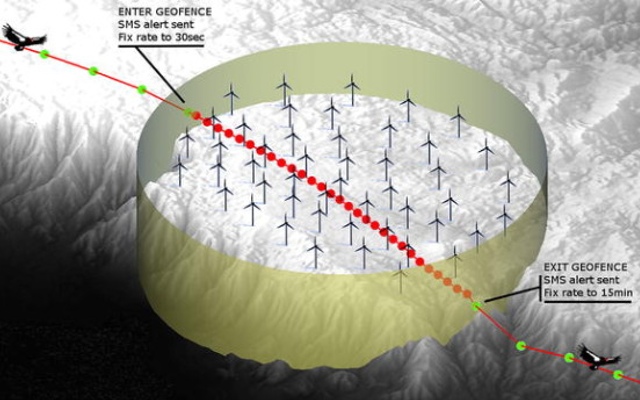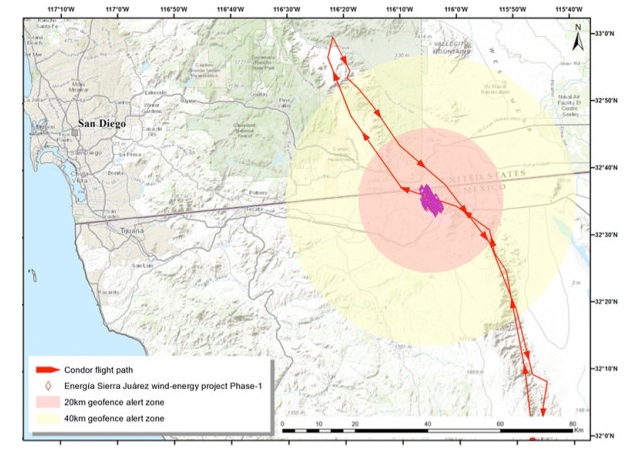Texas wind farm. Image: Leaflet
Nations around the world are finally making some hard-won headway in the effort to ditch fossil fuels for greener sources of energy, such as solar, hydro, and wind power.But while these emerging industries stand to drastically reduce greenhouse gas pollution—not to mention the major environmental disasters inherent to fossil fuels—they can still have some damaging consequences for local ecosystems. These need to be addressed.One of the most highly publicized examples of this problem is the myriad dangers wind farms pose to birds. Hundreds of thousands of birds are killed in collisions with turbines every year, prompting widespread discussion on how to protect fragile avian populations from this booming industry.Well, according to a recent study published in Animal Biotelemetry, the answer to this problem could be the development of geofences, which are virtual perimeters programmed to identify GPS and RFID tags. The study's authors, led by ecologist James Sheppard, propose enclosing wind farms with alert systems that give wind farm operators advance warning when tagged birds enter high risk areas. Depending on the situation, the turbines could be slowed or even stopped until the tagged animals safely exited the perimeter. "Geofence alert systems have been successfully deployed as an effective wildlife management tool for large mammal species, such as crop-raiding elephants in Africa and wild wolves reintroduced to North American parks," Sheppard, who is based out of the San Diego Zoo Institute for Conservation Research, told me over email."Until now, geofence units have been far too big to deploy on birds," he said. "Ours is the first system to shrink the tags all the way down to where they can be safely attached to a bird without affecting its flight, behavior, or survival."Sheppard and his colleagues tested out their miniaturized transmitters by helicoptering them through a geofence located on the flight path of a California condor. They made sure that the helicopter flew at the same height, speed, and trajectory as a previously tracked condos, for as realistic a simulation of this critically endangered species as possible.Sure enough, within a few minutes of the tags broaching the barrier, the team received SMS messages alerting them of the breach. Sheppard plans to build on the success of this initial prototype by developing more sophisticated transmitters designed to be carried by a variety of different animals that face survival pressures from wind farms.
"Geofence alert systems have been successfully deployed as an effective wildlife management tool for large mammal species, such as crop-raiding elephants in Africa and wild wolves reintroduced to North American parks," Sheppard, who is based out of the San Diego Zoo Institute for Conservation Research, told me over email."Until now, geofence units have been far too big to deploy on birds," he said. "Ours is the first system to shrink the tags all the way down to where they can be safely attached to a bird without affecting its flight, behavior, or survival."Sheppard and his colleagues tested out their miniaturized transmitters by helicoptering them through a geofence located on the flight path of a California condor. They made sure that the helicopter flew at the same height, speed, and trajectory as a previously tracked condos, for as realistic a simulation of this critically endangered species as possible.Sure enough, within a few minutes of the tags broaching the barrier, the team received SMS messages alerting them of the breach. Sheppard plans to build on the success of this initial prototype by developing more sophisticated transmitters designed to be carried by a variety of different animals that face survival pressures from wind farms. "Future iterations of the tags will be even smaller and lighter, enabling them to be deployed on a wider range of threatened bird species (and hopefully even bats)," he said. "We would also like to integrate the geofence alerts into a system that automatically shuts down wind turbines if a telemetered bird gets too close, without the need for a human intermediary."On top of that, the team hopes to equip geofence systems with buzzers, lights, and other alarms that could actively discourage birds from approaching turbines in the first place. All of these approaches, working in tandem, could mitigate the harsh effects of wind power on avian populations—and could even pioneer other models for protecting wildlife from human activity."The great thing about geofences is that they are entirely virtual—there is no physical infrastructure involved so their boundaries can be quickly placed around any site of concern and modified whenever and wherever needed," Sheppard explained."You can put geofences around a wind farm or an airport or a Starbucks," he continued. "We initially developed the geofence system to protect birds against wind farms, but you could install geofences around other sites where birds suffer collision injuries, such as solar energy developments or tall glass buildings."Given all the risks that bird populations already face in the 21st century, it's encouraging to know that scientists are well on the way to relieving at least one of the pressures on their survival. Wind power is a crucial cornerstone of the emerging green economy, and birds are essential to the health of the global ecosystem. Fortunately, as this new study demonstrates, those two realities do not have to be mutually exclusive.
"Future iterations of the tags will be even smaller and lighter, enabling them to be deployed on a wider range of threatened bird species (and hopefully even bats)," he said. "We would also like to integrate the geofence alerts into a system that automatically shuts down wind turbines if a telemetered bird gets too close, without the need for a human intermediary."On top of that, the team hopes to equip geofence systems with buzzers, lights, and other alarms that could actively discourage birds from approaching turbines in the first place. All of these approaches, working in tandem, could mitigate the harsh effects of wind power on avian populations—and could even pioneer other models for protecting wildlife from human activity."The great thing about geofences is that they are entirely virtual—there is no physical infrastructure involved so their boundaries can be quickly placed around any site of concern and modified whenever and wherever needed," Sheppard explained."You can put geofences around a wind farm or an airport or a Starbucks," he continued. "We initially developed the geofence system to protect birds against wind farms, but you could install geofences around other sites where birds suffer collision injuries, such as solar energy developments or tall glass buildings."Given all the risks that bird populations already face in the 21st century, it's encouraging to know that scientists are well on the way to relieving at least one of the pressures on their survival. Wind power is a crucial cornerstone of the emerging green economy, and birds are essential to the health of the global ecosystem. Fortunately, as this new study demonstrates, those two realities do not have to be mutually exclusive.
Advertisement
Advertisement
